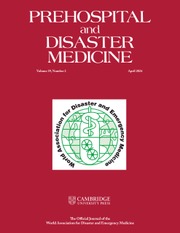No CrossRef data available.
Article contents
The Utilization of Hospital-Based Decontamination Facility for Chemical Incidents
Published online by Cambridge University Press: 13 July 2023
Abstract
The constraints of performing prehospital decontamination in mass casualty incidents involving the release of chemical agents at disaster sites in modern cities are notable. Compounding this are highly built-up urban areas with significantly high population density and traffic congestion. This places the burden of performing such decontamination on nearby healthcare facilities. Based on this need, public hospitals in Singapore have been equipped with decontamination facilities. We present a review of the utilization of this facility at our institution.
A retrospective review of the utilization of the hospital decontamination station (HDS) was carried out, noting its frequency, purpose, and outcomes.
Since its construction, the HDS has been deployed successfully many times a year for both routine training and disaster preparedness exercises. Despite the lockdown measures due to Covid-19, with concomitant reduction in social and economic activity, the HDS was activated five times for decontamination of chemical contaminated casualties. It is fortunate that, although HDS training activities were curtailed during this period, emergency department (ED) staff were still able to function effectively using prior experience, donning chemical protective suits, and performing decontamination. The semi-automated HDS facilitated rapid deployment which contributed to ease of use of this resource for timely decontamination of casualties with good outcomes.
Chemical incidents resulting in contaminated casualties are uncommon events. Nonetheless hospitals must be prepared to deal with this situation in a timely manner. The rapidly deployable HDS has become an important resource and an operationally ready solution for dealing with chemical contaminated casualties presenting at short notice to the ED. Regular training and deployment exercises utilizing the HDS provide staff familiarity critical to overall readiness for chemical incidents. This strategy provides a reliable countermeasure in an all-hazards approach to disaster preparedness at the hospital.
- Type
- Poster Presentations
- Information
- Prehospital and Disaster Medicine , Volume 38 , Supplement S1: 22nd Congress on Disaster and Emergency Medicine , May 2023 , pp. s172
- Copyright
- © The Author(s), 2023. Published by Cambridge University Press on behalf of World Association for Disaster and Emergency Medicine





